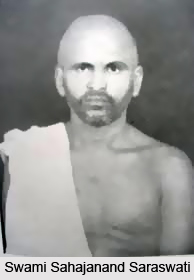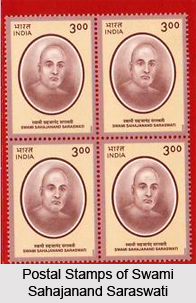 Swami Sahajanand Saraswati was a prominent leader of the peasantry in Bihar. He was an ascetical Dandi sanyasi of Gazipur district of Uttar Pradesh. He was well regarded as a peasant leader in eastern India. His social and political activities concentrated mostly on Bihar though he was born in Uttar Pradesh. He carried out most of his work from his ashram at Bihta, near Patna in the later part of his life. Government of India had issued in honour of the memory of Swami Sahajanand Saraswati a postal stamp, and the stamp was officially released on 26th June 2000 by Ram Vilas Paswan, the then Minister of Communications, Government of India.
Swami Sahajanand Saraswati was a prominent leader of the peasantry in Bihar. He was an ascetical Dandi sanyasi of Gazipur district of Uttar Pradesh. He was well regarded as a peasant leader in eastern India. His social and political activities concentrated mostly on Bihar though he was born in Uttar Pradesh. He carried out most of his work from his ashram at Bihta, near Patna in the later part of his life. Government of India had issued in honour of the memory of Swami Sahajanand Saraswati a postal stamp, and the stamp was officially released on 26th June 2000 by Ram Vilas Paswan, the then Minister of Communications, Government of India.
Early Life of Swami Sahajanand Saraswati
In a Jujhoutia Bhumihar Brahmin family, Swami Sahajananad Saraswati was born on February 22, 1889. This last of six sons was named Naurang Rai. When he was a child, his mother died and was brought up by an aunt. His father, Beni Rai, was principally a cultivator, even though a Brahmin. Naurang did very well both in the primary grades and in the German Mission high school where he studied English. Even from a very early age, signs of magnificence and incredulity of established populist religious practices could be seen in Naurang. Swami Sahajanand Saraswati was in query of spiritual solace mate by studying religious texts deeply and by abdicating the world His family had him married to a child bride in order to prevent him from doing this. In 1905 or early 1906, earlier the marriage could establish, his wife died.
Journey of Swami Sahajanand Saraswati
Naurang Rai was inducted into holy orders and conversantly took the name of Swami Sahajanand Saraswati, in 1907. He could not appear for the matriculation examination because of this espousal to sanyas. But this dedicated man spent the rest of his life, in studying religion, politics and social affairs. All these helped him to be radical.
Swami Sahajanand Saraswati came into limelight with his first participation from the primary castes Bhumihar platform. Slowly, Sahajanand got involved in nationalist Congress politics and later in peasant movements. Even in order to get involved deeply into the peasant movement, Sahajanand went through political schooling under Mahatma Gandhi, in the Indian National Congress. Sahajanand commenced off as a devoted Gandhian in Congress. He was an admirer of Gandhi`s fusion of tradition, religion and politics. By 1920, as directed by Gandhi, he threw himself into the nationalist movement.
Later on, Sahajanand though continued to be a member of the Congress but kept himself out of party politics. He fully turned to give his broadest energies into mobilising the peasants. He egresses as the foremost `kisan leader` by the end of the decade, in India. At different times while organising the peasants, with his political impulsiveness he became close to different individuals, parties and groups.
 In order to form the All-India Kisan Sabha, he joined his hands with the Congress Socialists. After that along with Subhas Chandra Bose, he initiated in organising the Anti-Compromise Conference against the British and the Congress. During the Second World War, he has worked with the CPI. At long last, he broke from them, to form an `independent` Kisan Sabha. Throughout all these political and social involvement, Sahajanand remained essentially a non-party man.
In order to form the All-India Kisan Sabha, he joined his hands with the Congress Socialists. After that along with Subhas Chandra Bose, he initiated in organising the Anti-Compromise Conference against the British and the Congress. During the Second World War, he has worked with the CPI. At long last, he broke from them, to form an `independent` Kisan Sabha. Throughout all these political and social involvement, Sahajanand remained essentially a non-party man.
Swami Sahajanand Saraswati was ascertained to improve the peasant`s condition. With that objective in mind, he pursued the issue with coerce and energy. For this effort he was almost universally loved by the peasants.
This Dandi Sanyasi was a powerful speaker speaking the language of the peasants. In the course of action, this staff became the symbol of peasant resistance.
Sahajanand died on 25 June 1950, while still the battle for this was being fought in the legislature and the courts.
At Neyamatpur, Gaya (Bihar), Swamiji has established an ashram which later became the centre of freedom struggle in Bihar.
Works of Swami Sahajanand Saraswati
Books
* Bhumihar Brahmin Parichay
* Jhootha Bhay Mithya Abhiman
* Brahman Kaun?
* Brahman Samaj ki Sthiti
* Brahmarshi Vansha Vistar
* Karmakalap
Autobiographical works
* Mera Jeewan Sangharsha
* Kisan Sabha ke Sansmaran
* Maharudra ka Mahatandav
* Jang aur Rashtriya Azadi
* Ab Kya ho?
* Gaya jile mein sava maas
* Samyukta Kisan Sabha
* Kisanon ke Dave
* Dhakaich ka bhashan
Ideological works
* Kranti aur Samyukta Morcha
* Gita Hridaya
* Kisanon ke Dave
* Maharudra ka Mahatandav
* Kalyan mein chapein lekh




















